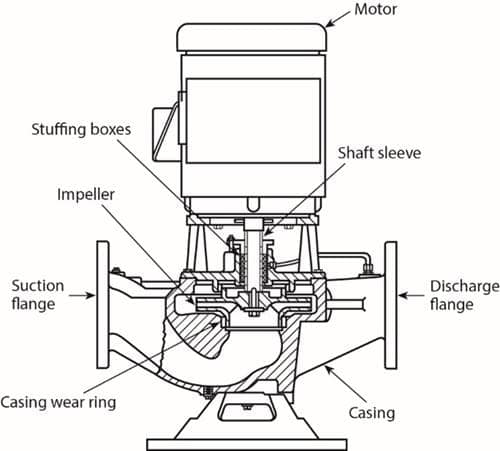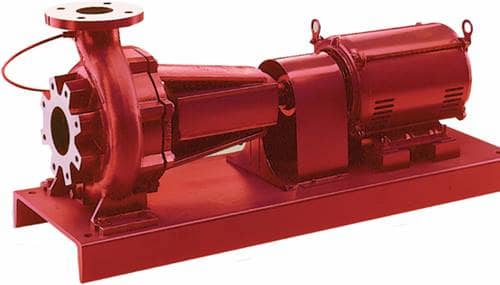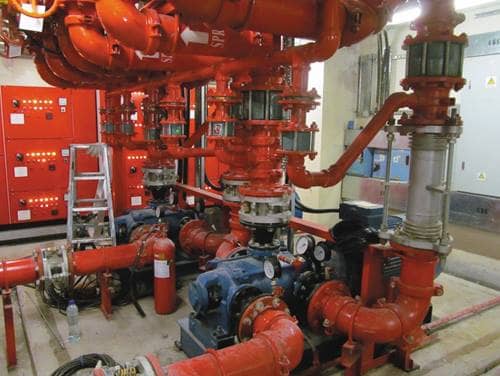Fire Fighting Pump.

Fire Fighting pump s are an essential part of many water-based fire protection systems. They are used to increase the pressure (measured in psi and bar) of a water source when that source is not adequate for the system it’s supplying. These are commonly found in buildings that tend to have a high-pressure demand such as high-rises or storage warehouses. Here we will review the different types of fire pump options available to designers.
There are many types of fire pumps available. It is important to select the correct type of pump for the installation project to avoid excessive costs, and to avoid excessive pressures that might damage your system. If all the factors are not taken into consideration it could result in a pump installation that does not achieve the necessary pressure requirements which could require a new pump tobe installed. Fire Fighting Pump.
There are two main categories of pumps: positive displacement and centrifugal.
Positive Displacement Pumps
Positive displacement pumps are characterized by a method of producing flow by capturing a specific volume of water per pump revolution and pushing it out through the discharge line. A bicycle tire pump is an example of a positive displacement pump we commonly see. Positive displacement pumps create very high pressures but have limited flow volume compared with centrifugal pumps. These are not as common because they have a specialized use, primarily with water mist and foam-water systems.
Centrifugal Pumps
Centrifugal pumps are the most common fire pumps and are used with most systems. With centrifugal pumps, pressure is developed principally by the action of centrifugal force or spinning. Water in centrifugal pumps enters the suction inlet and passes to the center of the impeller. The rotation of the impeller, in turn, drives the water by centrifugal force to the rim where it discharges. Centrifugal pumps can handle large volumes of water while providing high pressure boosts. Fire Fighting Pump.
The following are different centrifugal type pump configurations:
Horizontal Split-Case Pump
With a horizontal split-case pump, the flow is split and enters the impeller from opposite sides of the pump housing. As the name implies, this is a pump installed with a split casing that can be opened for pump maintenance access and is connected to the driver by a horizontal shaft.
They are very reliable, come in a wide range of rated flow and pressure capacities, are easy to maintain due to their relatively easy split-case access, and can be used with both electric and diesel drivers. However, these also typically need the most space of all types of fire pumps.
A vertical turbine pump is the only type of pump allowed by NFPA 20, Standard for the Installation of Stationary Pumps for Fire Protection that can start with negative suction pressure or take water under a lift condition such as from a below grade source such as a river or subgrade tank. These pumps can be used with raw water sources such as ponds, lakes, and rivers. Vertical turbine pumps come in a wide range of capacities and pressures, and they can be used with diesel and electric drivers.
In-Line Pump
In-line pumps are useful where space is limited. These can be driven by both a vertical or horizontal shaft (end suction type). Vertical shaft types, which are the most common, have the driver located directly above the pump. These are typically one of the less expensive units and take the least amount of space but, they are also one of the more expensive to repair. Pump maintenance and repair can be difficult because the motor must be lifted off and removed to gain access to the pump, unlike a split-case unit. With these pumps, the suction flange and discharge flange are on approximately the same plane. In-line pumps have a limited capacity of typically no more than 1,500 gpm (5,678 L/min), and they can only be used with an electric driver which limits their potential applications.
End Suction Pump
An end suction pump has a discharge outlet perpendicular to the suction inlet. These pumps are typically limited to a capacity of approximately 1,500 gpm (5,678 L/min). Compared to horizontal split-case fire pumps, they are more compact and require less installation space in a fire pump room where available space is a concern. End suction pumps can be used with either an electric driver or a diesel driver.
Multistage Multiport Pump
Multistage Multiport pumps use a single-driver that can be either an electric motor or a diesel engine that connects to a pump with multiple impellers in series in a single casing driven by a horizontal shaft. Fire Fighting Pump, The casing has multiple ports, or discharge outlets, delivering different pressures – each port has increased pressure from the consecutive series impellers. Fire Fighting Pump.
For example, Fire Fighting Pump, one multistage multiport pump could be installed in a high-rise building having 30 floors. The building may be divided into three zones where a multistage multiport pump equipped with three discharge outlets would use each outlet for a zone. The first has an outlet pressure of 100 psi (6.9 bar) and feeds lower floors or lower zone (ground to 9th), the second has an outlet pressure of 175 psi (12.1 bar) and feeds middle floors or mid zone (10th to 19th), and a third has a discharge pressure of 300 psi (20.7 bar) and feeds the upper floors or high zone (20th to 30th). Fire Fighting Pump.
Using multiport fire pumps could result in:
- Fewer pumps required
- Less pipe work and fewer valves, as one pump could eliminate the need for some control valves and pressure reducing devices, Fire Fighting Pump
- No requirement for water storage tanks on intermediate floors
- Lower structural loads and associated costs as only one pump may be required
- Energy conservation because less electricity and/or fuel will be consumed. Less pollution is also a potential benefit.
Conclusion
Ultimately there are several different pumps that can be used in a variety of situations. When your system demand exceeds what your water supply can provide it’s time to look at what a fire fighting pump can do to help bridge that gap. For more guidance see NFPA 20 for installation requirements and NFPA 25 Standard for the Inspection, Testing and Maintenance of Water-Based Fire Protection Systems, for ITM requirements.













No comments:
Post a Comment